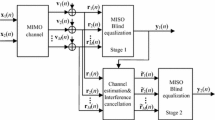Abstract
In this paper we address the problem of blind recovery of multiple OFDM data streams in a Multiple-Input Multiple-Output (MIMO) system. We propose an equalization algorithm which is based on a combined criterion designed to cancel both inter-symbol interference (ISI) and co-channel interference (CCI). ISI is minimized by using a modified Vector Constant Modulus criterion while CCI is minimized by a decorrelation criterion. We establish conditions for the existence of the stable minima corresponding to the zero forcing receiver which performs the joint blind equalization and the co-channel signal cancellation. The local convergence properties of the algorithm are proved under the assumption that the balance parameter weighting the two criteria is set appropriately. We also provide the optimal value for this parameter. Reliable performance is achieved with relatively fast convergence and small steady-state error. The implementation of the blind equalizer requires low-computational cost, without any matrix inversions or other expensive operations.
Similar content being viewed by others
References
Bai, W., & Bu, Z. (2004). Channel identification in MIMO-OFDM systems. In Proceedings of the IEEE 6th circuits and systems symposium on emerging technologies: Frontiers of mobile and wireless communication ’04.
Bai, W., He, C., Jiang, L., & Zhu, H. (2002). Blind channel estimation in MIMO-OFDM systems. In Proceedings of the IEEE global telecommunications conference, GLOBECOM ’02, Vol. 1, pp. 317–321.
Bölcskei H., Heath R.W., Paulraj A.J. (2002). Blind channel identification and equalization in OFDM-based multiantenna systems. IEEE Transactions on Signal Processing 50, 96–109
Brandwood D.H. (1983). A complex gradient operator and its applications in adaptive array theory. IEE Proceedings, Parts F and H 130, 11–16
Deneire, L., De Carvalho, E., & Slock, D. T. M.(1998). Identifiability conditions for blind and semi-blind multiuser multichannel identification. In Proceedings of the 9 IEEE SP workshop on statistical signal and array processing, pp. 372–375.
Du, J., Peng, Q., & Li, Y. (2003). Adaptive blind equalization for MIMO-OFDM wireless communication systems. In Proceedings of the international conference on communication technology proceedings, ICCT ’03, (vol. 2, pp. 1086–1090).
Godard, D. N.(1980). Self-recovering equalization and carrier tracking in two-dimensional data communication systems. IEEE Transaction on Communications, 7, 1867–1875. 1980.
Guo, B., Lin, H., & Yamashita, K. (2004). Blind signal recovery in multiuser MIMO-OFDM system. In Proceedings of the 2004 47th midwest symposium on circuits and systems, MWSCAS ’04.
Haun, M. A. (1999). The fractionally spaced vector constant modulus algorithm. M.S. Thesis, University of Illinois at Urbana-Champaign.
Jones, D. L. (2003). Property-restoral algorithms for blind equalization of OFDM. In Proceedings of the thirty-seventh Asilomar conference on signals, systems and computers, Pacific Grove, CA, (Vol. 1, pp. 619–622).
Luo Y., Chambers J. A., Lambotharan S. (2001). Global convergence and mixing parameter selection in the cross-correlation constant modulus algorithm for the multi-user environment. IEE Vision, Image and Signal Processing 148, 9–20
Papadias C.B., Paulraj A.J. (1997). A constant modulus algorithm for multiuser signal separation in presence of delay spread using antenna arrays. IEEE Signal Processing Letters 4, 178–181
Reed, I. S. (1962). On a moment theorem for complex Gaussian processes. IRE Transactions on Information Theory, IT-8 194–195.
Shin, C., & Powers, E. J. (2004). Blind channel estimation for MIMO-OFDM systems using virtual carriers. In Proceedings of the IEEE global telecommunications conference, GLOBECOM ’04, (Vol. 4, pp. 2465–2469).
Touzni A., Tong L., Casas R.A., Johnson C.R. Jr.(2000). Vector-CM stable equilibrium analysis. IEEE Signal Processing Letters 7, 31–33
Wang Z., Giannakis G.B.(2000). Wireless multicarrier communications. IEEE Signal Processing Magazine 17, 29–48
Wang, X. M., Lu, W.-S., & Antoniou, A. (2001). Blind adaptive multiuser detection using a vector constant-modulus approach. In Proceedings of the thirty-fifth Asilomar conference on signals, systems and computers, Pacific Grove, CA, (Vol. 1, pp. 36–40).
Yang, V. Y., & Jones, D. L.(1997). A vector constant modulus algorithm for shaped constellation equalization. In Proceedings of the thirty-first Asilomar conference on signals, systems and computers, Pacific Grove, CA, (Vol. 1 pp. 590–594).
Yatawatta, S., & Petropulu, A. P. (2003). Blind channel estimation in MIMO OFDM systems. In Proceedings of the IEEE workshop on statistical signal processing.
Zeng Y., Ng T. (2004). A semi-blind channel estimation method for multiuser multiantenna OFDM systems. IEEE Transactions on Signal Processing 52, 1419–1429
Author information
Authors and Affiliations
Corresponding author
Rights and permissions
About this article
Cite this article
Abrudan, T.E., Koivunen, V. Blind equalization in spatial multiplexing MIMO-OFDM systems based on vector CMA and decorrelation criteria. Wireless Pers Commun 43, 1151–1172 (2007). https://doi.org/10.1007/s11277-007-9291-2
Received:
Accepted:
Published:
Issue Date:
DOI: https://doi.org/10.1007/s11277-007-9291-2




